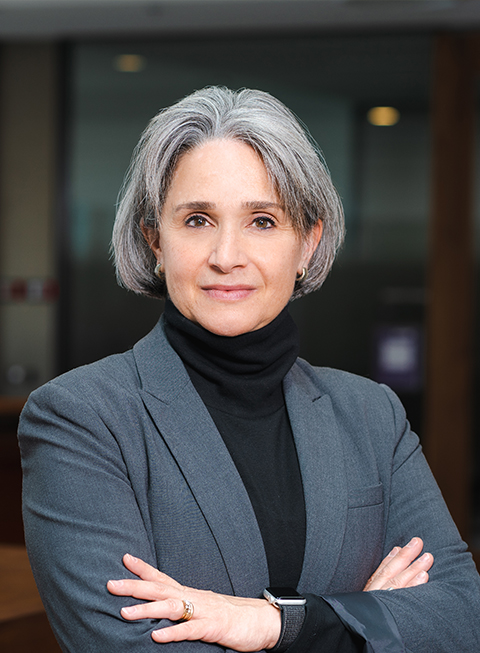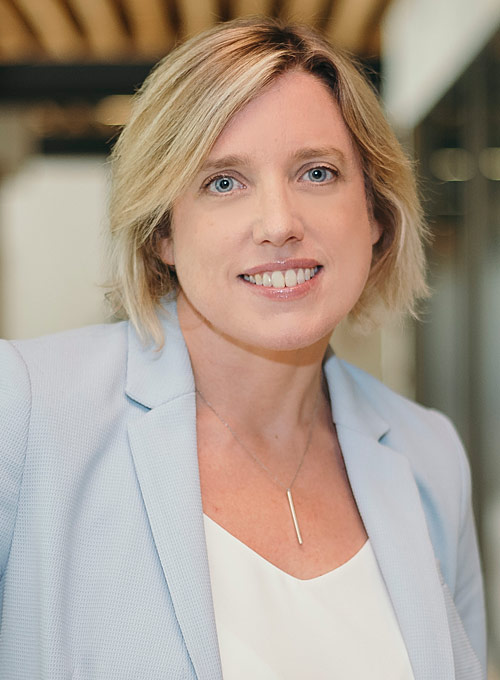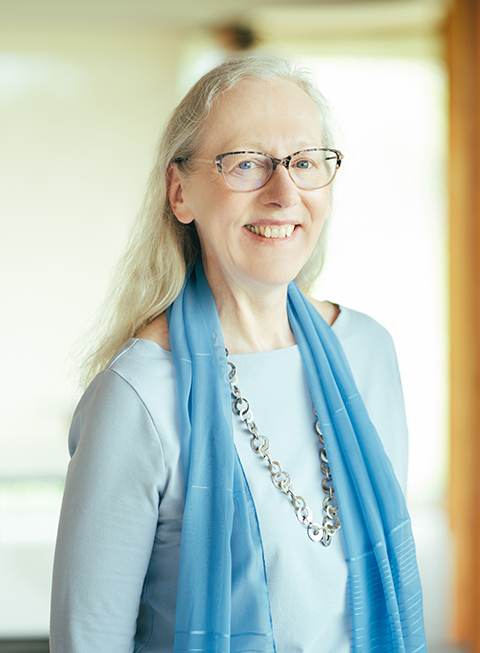This year’s International Women’s Day theme, #BreakTheBias, encourages us to raise awareness of the gender bias that may limit women’s success and take action for equality. Here’s a look at the Ivey research that’s making strides in those areas.
Kanina Blanchard:
Breaking the silence on intolerance and discrimination
Kanina Blanchard:
Breaking the silence on intolerance and discrimination
Kanina Blanchard’s advice:
Having spent most of her career as a woman leader in male-dominated fields, Kanina Blanchard has had first-hand experience with gender bias in the workplace.
She still clearly recalls an incident while working on a global leadership team in the oil and gas industry when a male colleague showed unbridled frustration and anger because she had to leave briefly to attend to a family emergency.
When she pivoted to academia and research later in life, Blanchard said she was shocked and saddened to see that some women in academia face a “chilly climate.”
Those experiences inspired her to share both her own accounts and those of others through her research on responsible leadership, women in leadership, and how to support Equity, Diversity, and Inclusion (EDI). That work includes her collaboration with colleagues Alison Konrad and Karen MacMillan, PhD ’13, on the Breaking the Silence case series, which focuses on the reality for women as well as those with multiple intersectionalites. The mini-cases in the series are based on real situations that leaders, professionals, and students have had with intolerance or discrimination – situations that are similar to those Blanchard saw or experienced in her own career or life.
“From the realities faced by students today in business school, to the realities in the world of work, it is both alarming and enlightening to recognize how little has changed in the last 35 years,” said Blanchard. “But there is also a tremendous opportunity to engage more fully – to break the silence.”
“It is both alarming and enlightening to recognize how little has changed in the last 35 years.”
The power of allyship
Case discussions aim to help people prepare or engage in the midst of similar situations with humility and vulnerability.
“From undergraduate to executive education, there is both a need and an interest to learn how to better have dialogue, step into awkward spaces, learn to not be a bystander, and try to support and be an ally,” said Blanchard.
So far the series has covered taboo topics, such as intolerance and bias, both on campus and at work. Soon to come in the series is a new case focused on the LGBTQ+ community that was spearheaded and co-authored by an Ivey student. Future case topics include the experience of the transgender community and issues for international students and employees.
Blanchard said the work is both timely and important given the increasing instances of intolerance and greater focus on social issues and challenges related to inequity and marginalization in the last few years.
Already she has had many volunteers offer to share their stories, which is further evidence of the need for society to reflect on intolerance and discrimination and commit to EDI practices.
“Consider the mini-cases to recognize the challenges that remain, those that are emerging, and the need for not just women, but allies, to engage,” she said.

Kanina Blanchard is an assistant professor of Management Communications and General Management
Janice Byrne:
Challenging the “superwoman” entrepreneur role model
Janice Byrne:
Challenging the “superwoman” entrepreneur role model
Janice Byrne’s advice:
Despite increasing efforts to showcase women entrepreneur role models in hope of encouraging more women to follow, the numbers are moving slowly.
Janice Byrne said it is important to consider whether aspects of the gender inequality “status quo” are being endorsed or condoned by these role models, perhaps unintentionally, when promoting entrepreneurship for women.
Byrne was part of a trio of researchers that examined more than 50 role models and the message being sent through a nationwide social media campaign to promote women entrepreneurs in France. Findings showed the role models consistently evoked an image of a heroic superwoman entrepreneur who does it all, reinforcing the contemporary pressure for women to work harder to succeed both personally and professionally.
Gender stereotypes in media
“These women role model entrepreneurs talk of how they work hard and believe in themselves. They have fun and achieve self-fulfillment. They do good and help others. Their stories are replete with ‘superwoman’ talk – a hectic, multi-tasking, juggling-act life is part of the deal,” said Byrne. “There are also back-stories of unfulfilled professional roles, work hours that are incompatible with family life, as well as ageism and micro-aggressions. These women’s obstacle-ridden pathways are offered as reasons for taking the plunge to start their own venture.”
Byrne said such messages normalize gender and other bases of inequality in the workplace and gloss over the fact that women still don’t have a level playing field. She also said she was surprised by the unquestioned use of role models in the policy campaign and the assumption that role models are always a good thing.
“Yes, we need more women entrepreneurs that are visible, but different types. As [Hidden Figures author] Margot Lee Shetterly said, we need to get away from talking about women or Black women succeeding and excelling as ‘exceptions’,” Byrne said, referring to Shetterly’s recent talk at Ivey. Shetterly’s book, Hidden Figures, tells the story of some Black women mathematicians who were integral to the U.S. space program in the 1960s despite antagonizing racial and gender stereotypes and laws.
“We need more women entrepreneurs that are visible, but different types.”
Since Byrne’s research on women entrepreneur role models was conducted in a French context, her future research will explore the Canadian context.

Janice Byrne is an assistant professor of Entrepreneurship
Alison Konrad:
Making the business case for gender and racial diversity
Alison Konrad:
Making the business case for gender and racial diversity
Alison Konrad’s advice:
Alison Konrad said it’s well-documented that firms with gender and racial diversity in leadership make longer-term investments in people and sustainability, which can lead them to outperform financially. But progress in Equity, Diversity, and Inclusion (EDI) depends heavily upon employers’ actions. That’s why she has dedicated her research to helping employers find ways to enhance EDI in their workplaces.
Konrad examines the impact of organizations’ EDI practices on women’s career progression as well as how having women in leadership encourages firms to add such practices to their people management systems. Her findings show EDI practices are positive predictors of gender and racial diversity in leadership, and in turn, diverse leadership teams are more active at implementing EDI practices.
The EDI advantage
“Together, these dynamics have the potential to create a virtuous cycle whereby more EDI moves a more diverse set of women into leadership, who then work to improve EDI implementation at the firm,” said Konrad.
She has also found ample proof of the benefits of diverse leadership teams. Konrad said more than 100 studies in a variety of fields document the beneficial effects of board gender and racial diversity for firm ethics, equity, transparency, and sustainability.
“I have been surprised at the consistency of findings across studies in my field as well as in the finance field,” she said. “These findings show that including more diversity on leadership teams can make a real difference for building businesses that will contribute to a more equitable and sustainable future.”
“More diversity on leadership teams can make a real difference for building businesses that will contribute to a more equitable and sustainable future.”
Konrad said more work is needed on ways to increase equity and inclusion for persons with disabilities, neurodiversity, and different expressions of gender identity in the workplace and she is currently working with students on research and case writing in these areas.
Shannon Rawski:
Tackling sexual harassment through training
Shannon Rawski:
Tackling sexual harassment through training
Shannon Rawski’s advice:
While working as a research assistant in the Industrial-Organizational Psychology department at Bowling Green State University during her undergrad, Shannon Rawski was surprised to learn many of her peers considered sexual harassment to be a "normal" occupational hazard.
“I still think of their stories and how these young women were affected by sexual harassment so early in their work lives,” she said.
She decided to study sexual harassment to better understand why it occurs and use that foundational knowledge to create more effective training programs. She has been dedicated to this research mission ever since.
Rawski’s research on sexual harassment focuses on understanding the behaviour, how it develops in work groups over time, and how it is interpreted. Findings show sexual harassment at work is often enacted in the guise of play, with harassers claiming they’re just joking. As a result, victims and bystanders may fear challenging the playful nature of a sexual joke or action will cause conflict or damage their work relationships.
Although sexual harassment affects men and non-binary individuals as well, Rawski said it is a well-known barrier to women's success and well-being in the workplace, especially women of colour, transgender women, lesbian and bisexual women, and other marginalized identities that intersect with gender. That’s why it’s important for sexual harassment training programs to be carefully designed so they motivate learning and behaviour change and avoid backlash effects. Rawski’s research also investigates the effectiveness of such training programs.
A new approach to sexual harassment training
“Companies spend a lot of time and money on training programs, but many do not evaluate whether their sexual harassment training programs work,” she said.
Her work on sexual harassment training shows employees respond better and learn more when they are encouraged to build skills to take on “hero roles.” Often sexual harassment training programs involve role-playing activities that depict harassers as “bad guys” or victims as “helpless,” which may create backlash. An example of such backlash is when a harasser escalates sexual behaviours at work, to prove a sexual joke is “funny” and not harassment.
“Companies spend a lot of time and money on training programs, but many do not evaluate whether their sexual harassment training programs work.”
To build on this research, Rawski said she’ll next explore how such programs can incorporate bystander/allyship training and new training technologies, such as virtual reality.
“The focus will be on how we can leverage training design and technology to give trainees a positive role, like an ally role, and build their skills to effectively execute that role when they return to work after training,” she said.

Shannon Rawski is an assistant professor of Organizational Behaviour
